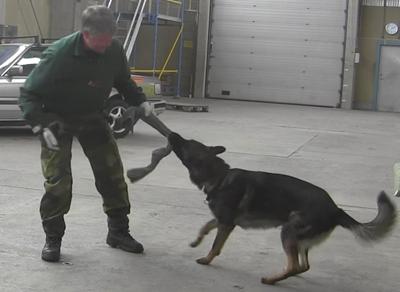Material & Methods

In 2005, the Swedish Armed Forces (SAF) started a breeding program of German Shepherd Dogs with the aim to recruit dogs to the Swedish military and police force. The goal of the breeding program is to produce 50 high quality working dogs per 200 puppies born each year (Wilsson & Sinn 2012). In average 35 litters are born every year at the SAF breeding kennel located in Sollefteå, northern Sweden (Wilsson & Sinn 2012). The puppies are group housed together with their mother and litter mates. When the puppies are 8 weeks of age they move to members of the Swedish public who volunteer as puppy raisers. The puppy raisers are instructed to do ordinary house training and basic obedience training with the dogs. The puppy raisers cares for the dog until it is15-18 months of age. At that time the dog is returned to SAF, to be tested in their standardised behavioural test used to select dogs that are suitable to go into the SAF training program to become a police- or military dog.
For each dog, an index value is also calculated (Wilsson & Sundgren 1997), based upon the ratings it has been given during the test. The index value ranges between approximately -100 and 109, a dog that gets an index value of 0 has 50 % probability of pass the SAF training program and end up as a successful military- or police dog[1] .
The standardised behavioural test is performed at five different test stations in Sweden; Ronneby, Göteborg, Märsta, Sollefteå and Luleå. In this study only three of the test stations were included; Göteborg, Märsta and Sollefteå. A total of 48 dogs (25 males and 23 females) that were tested by the SAF in Göteborg the 22th May, 11th September and 23-24th October, in Märsta the 28-30th August and in Sollefteå the 27th September 2012, a total of 8 test days, were video recorded during the whole standardised behavioural test. One video recorder was used and placed so that as much as possible of the dogs’ behaviour could be recorded, without disturbing or affecting the test. The same person performed all of the recordings. The dogs were 15-17 months old at the day of testing, except from one male that was 23 months old at the day of testing
[1] pers. comm., Erik Wilsson, Swedish Armed Forces Dog Training Center, Märsta, Sweden
Wilsson, E. & Sinn, D. L. 2012. Are there differences between behavioral measurement methods? A comparison of the predictive validity of two ratings methods in a working dog program.Applied Animal Behaviour Science, 141, 158-172.
Wilsson, E. & Sundgren, P. 1997. The use of a behaviour test for the selection of dogs for service and breeding .1. Method of testing and evaluating test results in the adult dog, demands on different kinds of service dogs, sex and breed differences. Applied Animal Behaviour Science, 53, 279-295.
Responsible for this page:
Director of undergraduate studies Biology
Last updated:
05/25/13
